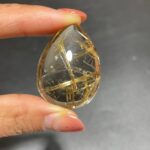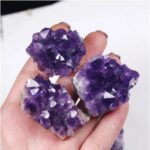Rocks that emit an otherworldly glow under the beam of a black light have captivated scientists and collectors alike for centuries. Their enigmatic luminescence adds a touch of magic to the natural world, inviting us to explore the hidden wonders that lie beneath our feet.

Fluorescence and Phosphorescence: Unlocking the Glow
The captivating glow of rocks under black light stems from two fascinating phenomena: fluorescence and phosphorescence.
Fluorescence
Fluorescence is the emission of light by a substance that has absorbed energy from a higher energy source, such as ultraviolet (UV) light. When the absorbed energy is released, it is emitted as visible light. This process typically occurs instantaneously, so fluorescent rocks glow as long as they are exposed to the black light.
Phosphorescence
Phosphorescence, on the other hand, is the emission of light that persists after the removal of the excitation source. Unlike fluorescence, phosphorescence involves the absorption of energy into an excited state that is then slowly released over time. As a result, phosphorescent rocks continue to glow even after the black light is turned off.
Types of Glow-in-the-Dark Rocks
Numerous types of rocks exhibit fluorescence or phosphorescence under black light. Some of the most popular and sought-after varieties include:
- Calcite: A common mineral that often fluoresces a vibrant orange or yellow under black light.
- Fluorite: Known for its intense fluorescence in a wide range of colors, including blue, green, purple, and pink.
- Willemite: A rare mineral that emits a brilliant green glow under black light.
- Scheelite: Characterized by a bright white or blue-white fluorescence.
- Powellite: A rare mineral that phosphoresces a bright yellow-green color.
| Mineral | Fluorescence Color | Phosphorescence Color |
|---|---|---|
| Calcite | Orange or yellow | No |
| Fluorite | Blue, green, purple, pink | No |
| Willemite | Green | No |
| Scheelite | White or blue-white | No |
| Powellite | No | Yellow-green |
Applications of Glow-in-the-Dark Rocks
Beyond their aesthetic appeal, glow-in-the-dark rocks have practical applications in various fields, including:
Geological Exploration
The presence and type of fluorescent minerals can provide valuable information about the geological history of an area. For example, the identification of uraninite, which fluoresces a distinctive green color, can indicate the presence of uranium deposits.
Archaeology
Black light is used to detect and document fluorescence from archaeological artifacts, such as pottery and cave paintings, to reveal hidden details and provide insights into ancient cultures.
Mining
Fluorescence can assist in the identification and extraction of valuable minerals, such as scheelite and willemite, from ore deposits.
Paleontology
Some fossil specimens, such as petrified wood and trilobites, exhibit fluorescence when exposed to black light, enhancing their visibility and facilitating study.
Jewelry and Decorative Arts
Glow-in-the-dark rocks are often incorporated into jewelry, home décor, and landscaping to create unique and captivating designs.
| Field | Application |
|---|---|
| Geology | Geological exploration and identification of minerals |
| Archaeology | Detection and documentation of artifacts |
| Mining | Identification and extraction of valuable minerals |
| Paleontology | Enhancement of fossil visibility and study |
| Jewelry and Decorative Arts | Incorporation into designs and home décor |
Inno-Lumination: Generating New Applications
The unique properties of glow-in-the-dark rocks have inspired a new realm of innovative applications. “Inno-Lumination” encompasses the creative exploration of these materials to develop novel products and technologies.
One promising area of exploration is the development of phosphorescent lighting systems. Powellite and other phosphorescent minerals could potentially be used to create sustainable light sources that emit glow for hours after exposure to sunlight or artificial lighting.
Furthermore, the ability of fluorescent minerals to interact with specific wavelengths of light opens up possibilities for selective sensing and detection applications. For example, researchers are investigating the use of fluorescent diamonds in bioimaging and medical diagnostics.
Frequently Asked Questions
Conclusion
Rocks that glow under black light are a captivating and enigmatic geological phenomenon. Their unique luminescent properties, ranging from the instantaneous glow of fluorescence to the persistent glow of phosphorescence, have inspired scientific advancements and opened up a realm of creative possibilities.
As research into these materials continues, the future holds the promise of even more innovative applications that harness the power of “inno-lumination” to enhance our understanding of the world and illuminate our path towards sustainability and discovery.




























